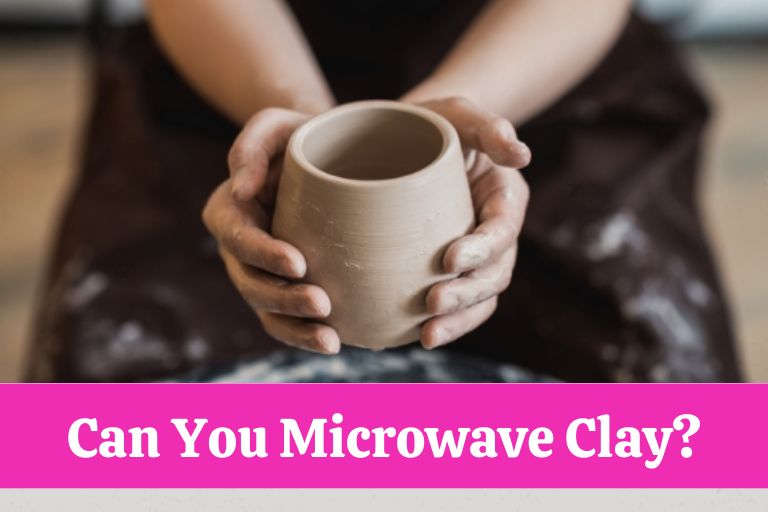Can you microwave clay? This is a question that many crafters and artists may ask themselves when working on their projects. From pottery to sculpture, clay is a popular medium for creating art, but not all material forms are suitable for microwaving.
In this blog post, we will discuss whether or not you can safely microwave clay and explore alternative heating methods.
Can you microwave clay?
No, it would help if you did not use microwave clay. When clay is heated in a microwave, it releases toxic fumes, which can be dangerous to inhale. Also, uneven microwave heating can cause the clay to warp or explode.
So, what are the alternative methods of heating clay? For starters, a heat gun or a toaster oven set to a low temperature can dry out wet clay and cure it for use. Polymer clay, for instance, can be baked in a traditional oven at low temperatures.
It’s always a good idea to check the instructions for the type of clay you are using, as some types may not be suitable for any heating.
How to Microwave Clay?
To microwave clay, it must be a type of clay that is microwave safe. Some types of clay, such as air dry clay, should not be microwaved as they can release fumes and potentially catch fire. If you have clay that is labeled as microwave-safe, you can soften it by following these steps:
- Roll the clay to an even thickness on a microwave-safe plate or dish.
- Cover the clay with a damp cloth or paper towel.
- Place the plate or dish in the microwave and heat it on a low power setting for short intervals (about 10-15 seconds), checking the clay frequently.
- Once the clay has reached the desired consistency, please remove it from the microwave and let it cool before use.
It’s always best to check the clay package for instructions or recommendations and to use caution when microwaving clay to prevent cracking or breaking.
FAQ:
Is clay safe in the microwave?
Not all clay is safe in the microwave. Some types of clay, such as earthenware, are not microwave safe and can crack or break in the microwave. Other types of clay, such as porcelain, are microwave safe.
Can clay pottery be microwaved?
Clay pottery should only be microwaved if it is labeled as microwave-safe. Some pottery is not microwave-safe and can crack or break in the microwave.
Can I microwave air-dry clay?
Air-dry clay should not be microwaved as it can release fumes and potentially catch fire.
How do you soften clay in a microwave?
To soften clay in a microwave, put a damp cloth over it and heat it for short intervals (about 10-15 seconds) until it reaches the desired consistency. Check the clay frequently, so it doesn’t get too hot.
How long do I microwave clay?
The amount of time needed to microwave clay depends on the type and amount of clay being heated. It’s best to start with a short interval (such as 10-15 seconds) and check the clay frequently.
Can clay mugs be microwaved?
Clay mugs can be microwaved if labeled as microwave-safe, but they should be used cautiously as they may crack or break in the microwave.
Which clay can be baked in the microwave?
Some types of clay are microwave safe and can be used for baking in a microwave. It’s always best to check the clay package for any instructions or recommendations.
How do you soften clay quickly?
To soften clay quickly, you can use a heat gun or place the clay in a plastic bag and use a rolling pin to flatten it.
What happens when the clay is heated too quickly?
When clay is heated too quickly, it can crack or become distorted. It’s important to heat clay slowly and evenly to prevent this.
What happens if you put clay in the freezer?
Putting clay in the freezer can cause the clay to crack or become distorted as the moisture inside the clay expands and freezes. It is generally not recommended to freeze clay.
How poisonous is clay?
Ingesting small amounts of clay is generally considered safe. However, consuming large amounts of clay or using it as a daily supplement may be harmful and cause stomach upset, constipation, or other health issues. It is not recommended to consume clay regularly.
How do I know if my pottery is microwave safe?
To determine if pottery is microwave safe, check for a microwave-safe label or consult the manufacturer. Avoid using pottery that is not labeled as microwave safe as it may crack or break in the microwave.
How do I know if clay is food safe?
To determine if clay is food safe, check for a safe food label or consult the manufacturer. Avoid using clay that is not labeled as food safe for any food contact surfaces.
Which clay is tasty to eat?
No clays are typically considered tasty for eating, as most clays are not intended for consumption and may contain impurities or be harmful if ingested.
What clay can I use to make mugs?
For making mugs, you can use earthenware, stoneware, porcelain, and other types of clay that are pottery-making friendly and microwave-safe. To ensure the clay you use is microwave safe, check the package or consult the manufacturer or a pottery expert.
What are the 4 stages of drying clay?
The four stages of drying clay are:
Plastic: The clay is soft and pliable.
Leather hard: The clay is firm and can be handled without distortion but has a high moisture content.
Bone dry: The clay has lost all visible moisture and is ready to be fired or painted.
Bisque fired: The clay has been fired at a low temperature to remove any remaining moisture and make it more durable.
What is the quickest drying clay?
The quickest drying clay is labeled as fast drying or air dry clay which dries at room temperature and doesn’t require firing.
Why is my clay cracking as it dries?
Clay can crack as it dries if it is too thick or too quickly. Other factors contributing to cracking include uneven drying or not allowing the clay to dry at the appropriate stages.
If you bake non-drying clay, it may not be fully dry, take longer, and harden properly. It may also release fumes or catch fire.
How do you bake clay without a kiln?
To bake clay without a kiln, you can use a kitchen oven. Make sure to use an oven thermometer to reach the right temperature, and also use oven mitts and eye protection. The temperature should be low, around 265F, for 15 minutes; check the package instructions of your clay or consult a specialist first.
How long does it take for clay to dry?
The time it takes for clay to dry can vary depending on the thickness of the clay, the humidity, and the temperature. Air-dry clay can take several hours to several days to dry completely. It is important to dry clay slowly and evenly to prevent cracking.
Conclusion:
In conclusion, it’s best to avoid microwaving clay as it’s unsafe. Instead, use alternative heating methods such as a heat gun or a toaster oven set to a low temperature. Remember to always check the instructions for your clay before starting any projects. Feel free to leave a comment or reach out if you have any other questions regarding working with clay




